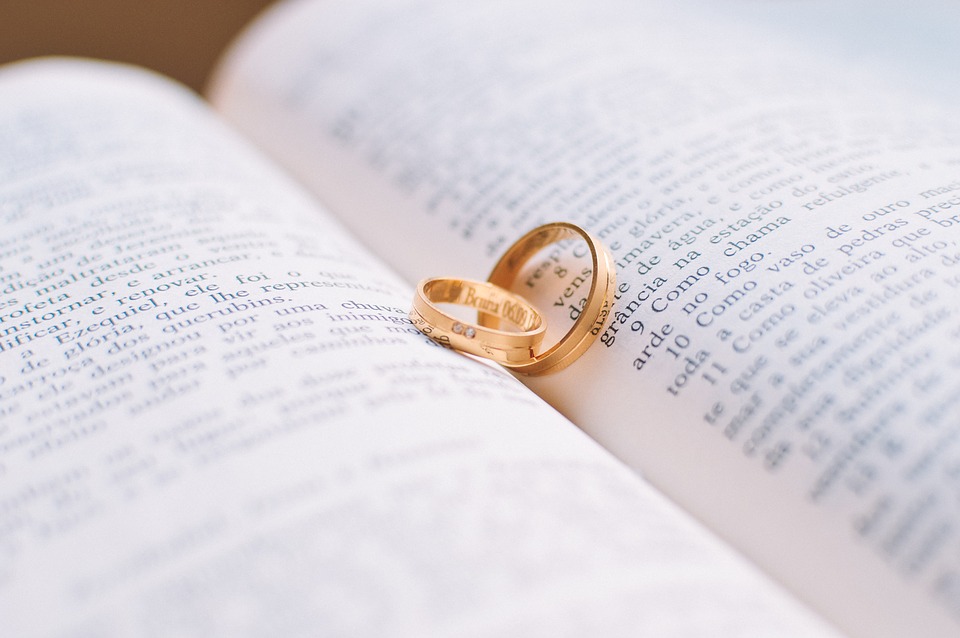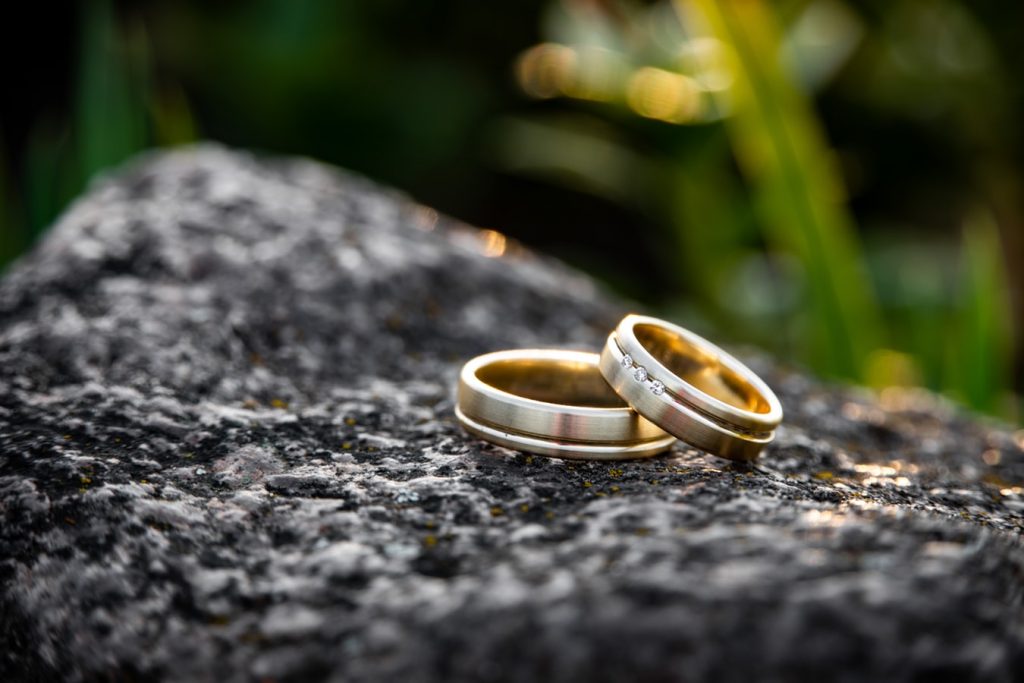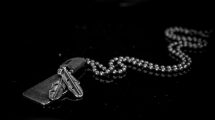As Wedding Know How editors, we write about things that we love and we think you'll like too. We have affiliate partnerships and sponsorship and may generate some revenue from these at no cost to you.
In the past, your best choices for wedding band metals were gold, platinum and silver. But today, there are so many options on the market.
From meteorite rings to tungsten to dinosaur bone inlay rings, the choices reach from space to earth and can make it really bewildering.
Let’s take a look at the top wedding band metal choices, considering their pros and cons.
What to Consider Before You Choose
When choosing your metal, there are a few considerations that you must take into account. Remember that these guidelines apply to both men and women. These factors include:
- Durability – A wedding ring is a piece of jewelry that you’ll wear for the rest of your life. Most people wear this daily and never take it off. As such, durability is a heightened concern, because you’ll want to make sure that you’re ring can withstand the knocks and bumps that daily life will throw at it.
- Beauty – You’ll want to pick a metal that complements your skin tone and has a texture and look that you love.
- Value – Wedding band metals range from a few dollars to thousands of dollars. Where on that spectrum do you want your ring to fall? Does it matter to you that your ring doesn’t have monetary value but only sentimental value? Considering this will help you to decide on your budget.
- Uniqueness – Some people want to stick with the traditional metals, because after all, they’re classics and have lasted the test of time. Others want something more offbeat, that’ll stand out, be a talking point and break the norm. Which category interests you?
- Maintenance – Some metals are just easier to take care of and require minimal maintenance, whereas others may require periodic replating or polishing.
- Lifestyle – The kind of work you do will guide your choice of metals to some extent. For example, if you work with heavy machinery, you might want to stick with a metal that shatters but doesn’t bend as a safety measure. If you use your hands a lot at work, durability becomes even more important.
Once you’ve got these basics out of the way, it becomes easier to zero in on the right metal for you. Here’s a list of metals perfect for wedding bands.
Which is the Best Metal?

It’s hard to pick out one out of all the metals listed here and say – this is the best. Each metal has its pros and cons and can be the ‘best’ depending on what you’re specifically looking for.
When trying to select the right metal, some factors to consider are durability, price, social recognition, uniqueness.
Here are the best metals for:
- Durability – Tungsten (ranks Mohs 9)
- Prestige – Platinum (the most expensive metal)
- Price –Stainless steel (the most affordable)
- Tradition – Gold (the oldest metal used in jewelry)
- Uniqueness – Meteorite (it’s out of this world)
- Appearance – Mokume Gane (but this is subjective)
With that as a taster, let’s take a look at the different types of metals used in creating wedding rings.
1- Gold

The most traditional of all metal types for wedding bands, gold has been used since ancient times. Gold is prestigious, always retains its value and classic. It’s the quintessential choice for a wedding ring.
When choosing gold, you’ll have to pick the purity or karatage of the metal too. Gold typically comes in 14K or 18K varieties, which refers to the amount of pure gold in the alloy. So a 14K gold ring contains 14/24 parts of gold. The rest is made up of other metals to add strength and durability to the gold. The higher the gold purity, the more expensive the metal.
Gold in its pure form is hypoallergenic, but when alloyed, this can be compromised. Nickel or other common metal allergens may be present, especially in white gold.
Gold can get scratched and dented over time, but your jeweler should be able to polish it back to its lustrous self for you. It’s a relatively easy metal to maintain (except for white gold). Gold comes in a range of colors to choose from:
- Yellow Gold – Gold, in its pure form, is yellow in color and known for its warm, soft hue.
- White Gold – This is made by alloying yellow gold with whitish metals like palladium and nickel. A layer of rhodium is plated on the surface to give the white gold its reflective, mirror-like luster. White gold needs to be replated every year or two, as the rhodium may flake off over time. White gold is a less expensive alternative to platinum.
- Rose Gold – A delicate, soft hue, rose gold is made by combining gold with copper. It’s a stylish, beautiful color and while it might seem feminine, it’s the perfect unisex color. This metal color is modern and fashion-forward.
- Green Gold – This is an alloy generally made by mixing gold with silver. The result is a greenish shine that’s very subtle. You might not even notice it properly unless you compare it against another metal.
2- Platinum
The most expensive and prestigious of all the wedding band metals, platinum is also the most precious. It’s much rarer and this reflects in its price too. However, it’s interesting to note that palladium (one of the platinum group of metals) has exceeded it in price once or twice in recent years.
Platinum is highly durable, because of its high density, but over time, it can develop a patina. While some love the look of an aged patina, others might prefer a more lustrous reflection. If this happens, you can have your platinum ring polished at the jewelers to regain its luster as it’s easy to maintain.
Platinum remains one of the most popular metals due to its wearability, beautiful luster and hypoallergenic nature.
3- Palladium
Palladium used to be a less expensive alternative to platinum until it started going up in price. Today, if you choose palladium, it wouldn’t be as a cheaper alternative but more for the love of the metal itself.
Palladium was made a precious metal in 2010 (along with gold, silver and platinum). It’s slightly more durable than platinum and better than white gold in that it doesn’t require period replating. The luster and color of palladium is natural and easy to maintain.
The downside?
Palladium is very rare so finding a wedding ring made of this metal will be more restrictive than the other more popular and available metals.
4- Silver
Silver, like gold, comes in a few different versions. You’ve got fine silver (99.9% purity), sterling silver (92.5% purity) and Argentium silver among others.
Fine silver is too soft for jewelry and especially for wedding rings, because it tends to lose shape and easily scratch. Avoid fine silver for a ring you plan to wear daily.
Sterling silver is the most popular silver alloy and consists of 92.5% real silver. However, because the rest of the alloy is made up of copper, which tarnishes easily, sterling silver is known for changing color and oxidizing over time. Not the best choice if you want minimal maintenance. On the plus side, it’s a lot more affordable than most other metal types.
Argentium silver is a new variety of silver. Argentium is the brand name of this alloy and only licensed retailers can sell this. The benefit of Argentium silver is that its highly tarnish resistant, durable and hypoallergenic. It has all the benefits of sterling silver without the annoying maintenance issues. It is slightly more expensive, however.
5- Titanium
It’s not for nothing that Sia sings about being titanium. This metal is extremely durable ranking at 6 on the Mohs scale. Titanium is very easy to maintain because it’s resistant to scratches and damage, which is perfect if you use your hands a lot for work. You won’t have to worry about damaging your ring when you knock it about.
It’s also very lightweight, making it comfortable to wear. For some, though, it’s a bit too lightweight, so if you like the feel of a heavy ring on your finger, this might not be the one for you.
Titanium is very affordable, compared to the precious metals but it’s beautiful luster and color can make it pass for a more expensive metal. To add to the benefits, it’s also hypoallergenic and very safe to wear.

Any downsides?
Titanium can be difficult to resize, and some jewelers may refuse to undertake resizing. Consider this when deciding on titanium because all wedding rings may need to be resized at some stage down the track as your finger size changes with age.
6- Tungsten
Tungsten is the hardest metal used in jewelry, ranking at 9 on the Mohs scale (that’s the same as sapphire and ruby, while diamonds are a 10). What this means is that your tungsten ring is nearly indestructible. It’s highly resistant to damage and getting scratches and remains lustrous for years.
This durability is a double-edged sword because it means that working with tungsten can be difficult for jewelers. Resizing is near impossible and designs are limited because you can really get tungsten to do all the things you want, unlike a metal like gold.
Because tungsten is brittle, it shatters rather than bends, meaning that its great for someone who works with heavy machinery or does similar work. You know that ring won’t bend into your finger in case of an accident.
Tungsten is affordable and can be plated to come in different colors. It’s heavier than most other metals, so in that respect, it’s the opposite of titanium.
7- Carbon Fiber
This one’s a cool material, in that it’s not a metal. It’s a space age material and has its origins in the space program. It’s a modern, space age choice.
Carbon fiber is made of tightly woven fibers which create a tough fabric. This gives it a unique texture compared to metals. You might think that this reduces its durability, but in fact, carbon fiber is one of the toughest materials used in wedding rings.
Rings made from carbon fiber are so light that they almost feel eerie. Some people just don’t like the feeling while others love it. It’s a subjective thing and you probably won’t know until you wear one.
Some other benefits include being hypoallergenic, easy to maintain and affordable. The downsides are that it’s very difficult to resize and comes mainly in black with limited designs.
8- Cobalt
Cobalt looks like white gold or platinum, with a similar luster and color. They’re very reflective and have a beautiful look to them. Another popular color for cobalt rings is black, especially in a brushed finish.
While cobalt has a pricey look, these rings are relatively affordable, compared to their precious metal counterparts. They’re hypoallergenic and easy to maintain, because they’re highly resistant to scratches and damage.
Like most of the alternative metals, though, cobalt too is difficult to resize or even to engrave. This can be a deal breaker for some people. However, on the upside, these rings are hypoallergenic, easy to maintain and affordable. They’re great for daily wear and don’t require any replating or specific maintenance.
9- Tantalum
Tantalum has a grayish hue but is highly shiny and has a reflective quality that makes tantalum rings very beautiful. They’re hypoallergenic, easy to maintain and are an excellent choice for daily wear. Tantalum also doesn’t conduct heat, so it’s ideal for people in certain jobs, like electricians.
Tantalum isn’t as affordable as some of the other metals on this list, like titanium or tungsten. It’s a lot more expensive because it’s in high demand and is extremely rare. Experts say that primary tantalum sources will run out in the near future. This adds a certain allure to the metal and for some, is a good reason to opt for it.
On the downside, there’s controversy regarding tantalum mining practices. As a result of this, it’s been classed as a conflict resource. This can be a deal-breaker for some couples.
10- Meteorite
Yes, you read that right. Meteorite rings are made from you guessed it, meteorites that have fallen to earth. This is a metal that’s out of this world (quite literally) and perfect for couples who want something unique, special and unorthodox.
Meteorite rings have interesting natural textures which add to its beauty. They’re comfortable to wear and are a cool conversation starter.
Not every meteorite is suitable to be made into rings and probably the best known is Gibeon Meteorite. Always check for authenticity when purchasing meteorite.
On the downside, meteorite rings tend to rust quite easily and taking care of them can be a job and a half. The iron content in the meteorite is responsible for the rusting and there’s not much that can be done about that apart from following a strict maintenance regimen.
It’s well worth the time you put into keeping the ring lustrous because, after all, how many people do you know have a ring made from a meteorite?
11- Stainless Steel
One of the most commonly used alloys, stainless steel is a practical, common sense metal that does the job if you’re looking for a wedding ring. It doesn’t have the romance, value and prestige of some other metals included on this list, but not everybody is looking for those characteristics.
One thing to note: Stainless steel is a bit misleading because this alloy can stain and discolour over time but it stains-less than other metals.
Some benefits of stainless steel are that it’s highly reflective and lustrous and has a color like white gold. It’s easy to maintain and durable and because it’s affordable, it suits all budgets.
However, on the downside, it can be difficult to resize a stainless steel ring because the metal isn’t very workable. Also, stainless steel rings come in limited styles, again due to the fact that they aren’t easy to work with.
This is perfect for someone looking for a beautiful yet affordable and practical ring.

12- Mokume Gane
Technically we shouldn’t be including mokume gane in this list but it’s so unique that it almost counts as a separate metal. Often considered the highest level of metalsmithing, mokume gane is not a metal per se but rather a Japanese technique that manipulates metal.
It’s made by layering several sheets of differently colored metals (say copper, brass and silver) and then working these with force and heat to create intricate patterns. The trick with this is to make the layers bond but not melt. As you can imagine, this requires immense skill.
The end result of mokume gane is a metal that’s unlike anything you’ve ever seen. It’s the perfect combination of these different layered metals, creating intriguing patterns and textures.
Mokume gane is for you if you want more than just a boring, traditional ring. On the downside, these rings tend to cost a fair bit and can require some dedicated maintenance to ensure that they don’t tarnish.
13- Damascus Steel
Like mokume gane, Damascus steel is an alloy of iron and stainless steel. But because these are less expensive metals, the overall price of Damascus steel rings are lower than mokume gane rings.
Damascus steel rings have beautiful natural patterns and textures that are worked to life by combining the different layers of metal. Each ring is unique and you won’t be able to find two identical Damascus steel rings.
If you’re wondering if these rings are hypoallergenic, this depends on the quality of the metals used in the alloy. Damascus rings are highly durable and relatively easy to maintain. They’re stylish and different and perfect for someone after a unique choice.








